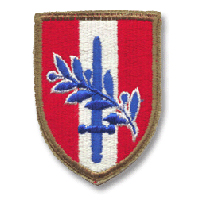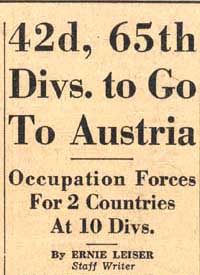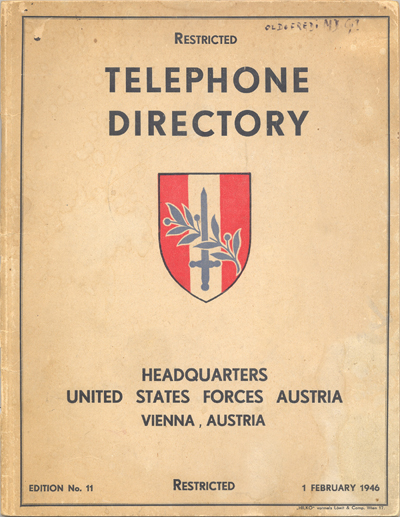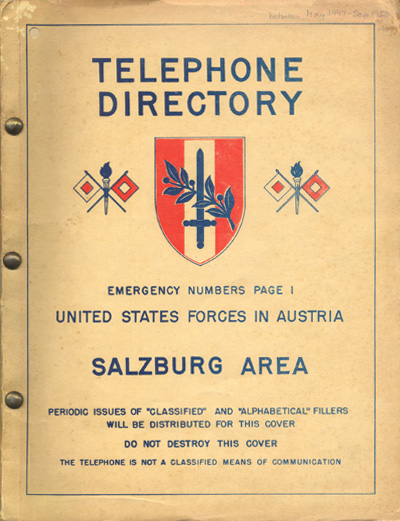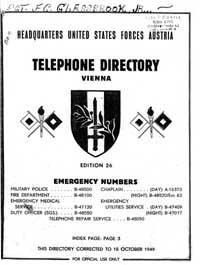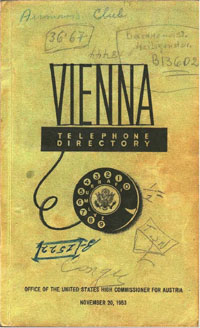If you do NOT see the Table of Contents frame to the left of this page, then
Click here to open 'USArmyGermany' frameset |
Headquarters, U.S. Forces, Austria
European Command
Looking for more information from military/civilian personnel assigned to or associated with the U.S. Forces, Austria from 1945 to 1955. If you have any stories or thoughts on the subject, please contact me . . |
|
|
|
|
|
| |
| USFA History |
|
| 1945-49 |
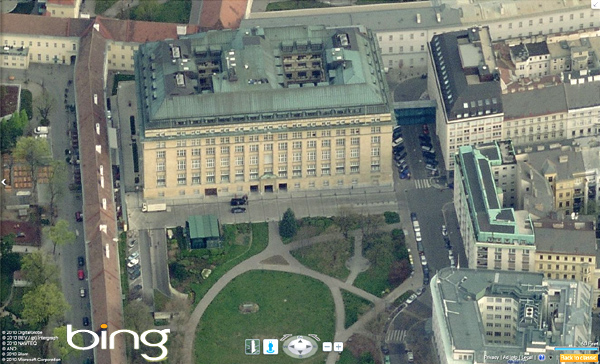
Bank Building, former USFA Headquarters in Vienna (Bing Maps) |
| |
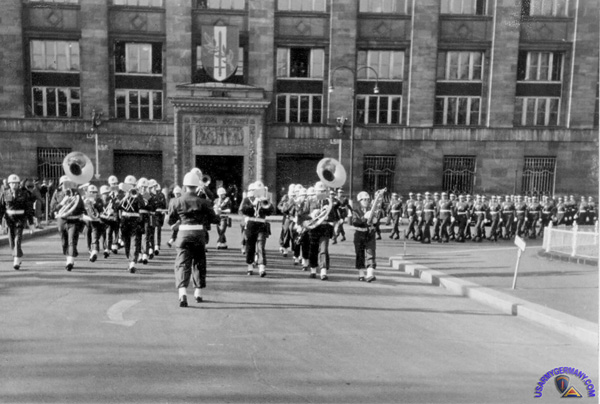
Retreat parade in front of HQ USFA Bldg, Vienna (John Davis) |
| |
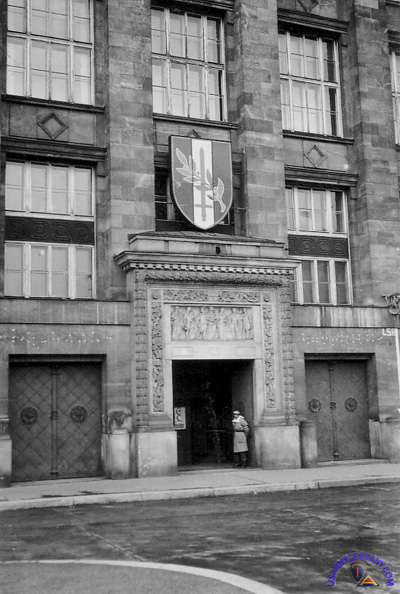
Guard duty (202nd MP Co) at HQ USFA, Vienna (John Davis) |
|
|
| |
| Commanding generals, US Forces, Austria |
| |
1945 - 1955 (1) (2)
- Gen Mark W. Clark (July 1945 – May 1947)
- Lt Gen Geoffrey Keyes (May 1947 – October 1950)
- Lt Gen S. Leroy Irwin (October 1950 – April 1952)
- Lt Gen George P. Hays (April 1952 – April 1953)
- Maj Gen William H. Arnold (May 1953 – September 1955)
(1) List was created based on information collecting during research in the STARS & STRIPES archives. If anyone has corrections or additional details, I would like to hear from them.
(2) USFA CG quarters were located in the Villa Warsberg, in Salzburg-Nonnstal (Brunnhausgasse 24). The villa was requisitioned by the US Army and returned to the Austrian government in October 1955. The villa was torn down in 1962. |
|
|
|
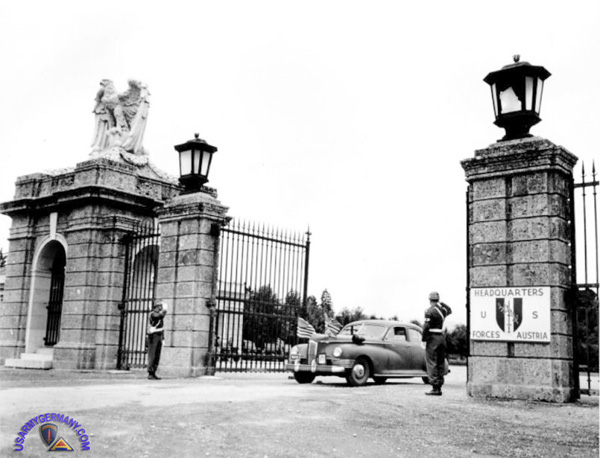
Schloss Klessheim, Salzburg, first USFA Headquarters in Austria (Bing) |
|
|
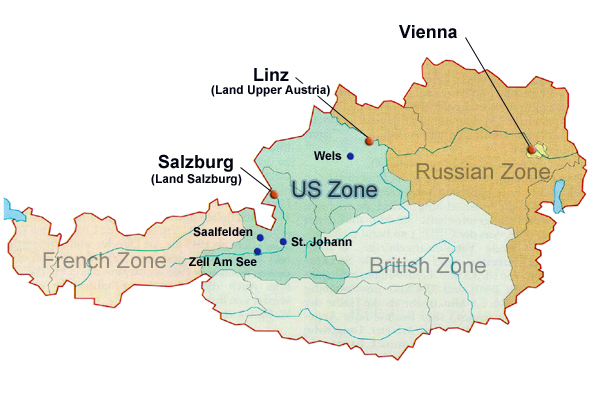
U.S. Zone, Austria (Walter Elkins) |
|
|
| 1945 |
| (Source: Occupation Forces in Europe Series - The First Year of the Occupation. Published by the European Command, 1947.) |
Planning for the Occupation of Austria
The assumption of quadripartite control was a slower process in Austria (than in Germany) and was not completed until August 1945. Planning, however, had started in 1944, and from the beginning, a clear distinction had been made between the status of Germany and Austria.
It was originally decided by the Combined Chiefs of Staff that the Allied planning organization in England would coordinate plans for the occupation of Austria with those for Germany, but that Austria would be initially under the Mediterranean Theater because forces for the occupation could be provided more quickly from there. The US Group Control Council (Austria) was established in the Mediterranean Theater on 27 January 1945, and the London planning staff started its move to Italy early in February 1945.
In December 1944 the proposal that Austria be divided into three zones was made by the Soviet representative to the European Advisory Commission. In March 1945 the four-power occupation of Austria was being considered by that body, but agreement was not reached until early in July.
Events early in April 1945 forced changes in the plans for Austria. Soviet forces crossed the Austrian border early in April and captured Vienna on 13 April. Meanwhile, the weakening resistance of the Wehrmacht in Germany indicated that United States forces could invade Austria from the northeast more easily than from the south. Part of General Eisenhower's forces were turned south, therefore, and penetrated into Austria before the Germans could assemble their forces in the mountain "redoubt" of southern Bavaria and western Austria. Control was transferred from the Mediterranean to the European Theater of Operations, except that the former Theater was directed to furnish military government personnel and the headquarters staff for the occupation forces.
Interim Period of Tactical Military Government
After V-E Day it was necessary to continue tactical military government in Austria for a few weeks until military government field detachments were in position. When the first members of the military government staff arrived at the end of May, they found a confused situation, due to the territorial disposition of units. Troops in Austria comprised all or parts of two army groups, two field armies, four army corps, and twelve divisions, many of which were partly in Germany and partly in Austria. Consequently, their instructions and policies were not exclusively directed towards Austria (see List of Major Commands and Units for more details). During the early period Austria had to be treated on the same lines as Germany.
Development of an Austrian Command
This situation was improved, however, in July. On 5 July 15th Army Group was reorganized and redesignated the US Occupational Forces Austria. The Headquarters Company II Corps, 11th Armored Division, 42nd Division and 65th Division, previously assigned to Third Army and 12th Army Group, were assigned on 6 July to the newly formed US Occupational Forces Austria, the commanding general of which was Gen Mark Clark.
The Place of Austria in the European Theater Organization
The command directive for Germany and Austria, which was adopted by the Joint Chiefs of Staff on 28 June 1945, provided that General Eisenhower as Commanding General of the European Theater should delegate to the Commanding General of the United States forces in Austria such operational control as he considered necessary, and that two divisions should be assigned to Austria. This provision was elaborated in the Allied Forces Headquarters document that established the US Occupation Forces Austria. General Clark was made directly responsible to the Joint Chiefs of Staff on military government and political matters, while remaining under the European Theater on matters of supply and administration. Responsibility for the logistical support of forces in Austria was delegated to the Third Army, and later to Continental Base Section. Thus, the Austrian command assumed its place within the European Theater, retaining, however, a considerable measure of independence as regards policy, military government, and operation.
Final Establishment of Occupation in Austria
One of the earliest major accomplishments of this period was the final establishment of the occupation in Austria. On 19 August the advance headquarters of US Forces Austria moved into Vienna; after a series of conferences with Soviet officials, the commanders in chief of the other three occupying powers, Gen Mark Clark, Lt Gen Sir Richard McCrery, and Gen Marie-Emile Bethouart, moved into the city on 23 August. The Soviet forces were under the command of Marshal Ivan S. Koniev.
By September 1945 the United States Sector of Vienna was established, comprising the districts of Neubau, Josefstadt, Alsergrund, Währing, Döbling, and the northern part of Hernals adjoining Währing (see map). On 11 September the Allied Control Council met for the first time.
Two of the major achievements of quadripartite control during this period were the extension through the whole of Austria of the power of the Provisional Government under Dr. Karl Renner on 20 October, and the preparations for, and supervision of, the first free elections for the national and provincial legislatures of the postwar period. This was held on 25 November 1945, with approximately 93 percent of the registered voters participating. Eighty-five Volkspartei members, 76 Social Democrats, and 4 Communists were elected to the Nationalrat, or Lower House of Parliament; Volkspartei majorities were elected to the provincial legislatures in all the Länder except Vienna and Kärnten (a Land of the British Zone), where socialists formed the majority. Leopold Figl, chairman of the Volkspartei, was elected chancellor of the new government, which was formally approved on 14 December by the Executive Committee of the Allied Control Council. |
|
|
NOTES:
- SHAEF: The Supreme Headquarters Allied Expeditionary Force (SHAEF) was established on February 13, 1944, as an integrated U.S.-British organization responsible to the Combined Chiefs of Staff. On July 14, 1945, SHAEF was discontinued, and its civil-affairs and military government functions were assumed by the Allied Group Control Council, in Berlin.
- European Advisory Commission: History: EAC established, with seat in London, by a secret protocol signed by U.S., United Kingdom, and USSR representatives at the Tripartite Conference in Moscow, November 1, 1943, with responsibility for making recommendations to the three Allied governments on questions connected with the termination of the war in Europe. Provisional Government of the French Republic accepted into membership, November 27, 1944. EAC's 12 recommended formal agreements, all of which were eventually accepted by all member governments, concerned surrender terms for, and postwar administration of, Germany and Austria; and armistice terms for Bulgaria. EAC abolished, September 10, 1945, pursuant to Section I of the Protocol of the Proceedings of the Berlin Conference (also known as the Potsdam Conference), August 1, 1945. By Sections I and II of same protocol, responsibility for drawing up peace treaties with the former European Axis powers vested in a Council of Foreign Ministers of China, France, United Kingdom, United States, and USSR; and responsibility for administering occupied Germany vested in Control Council.
- US Allied Commission for Austria: USFA, USACA Section, responsible for civil affairs/military government administration, was organized concurrently with the establishment of HQ USFA by General Order 1, HQ USFA, July 5, 1945, as a component of U.S. Forces, European Theater (USFET). The single position of Commanding General USFA and U.S. High Commissioner for Austria was held successively by Gen Mark W. Clark, July 5, 1945 - May 16, 1947; and Lt Gen Geoffrey Keyes, May 17, 1947 - September 19, 1950. USACA Section provided the U.S. element of organizations comprising the Allied Commission for Austria, the name of the four-power occupation administration established by a U.S., British, French, and Soviet agreement, signed July 4, 1945, and made effective July 24, 1945. USACA Section also administered occupation government in the U.S. Zone of Austria and U.S. Sector of Vienna. USACA Section was abolished following transfer of U.S. occupation government from military to civilian authority, marked by the Presidential appointment of Walter J. Donnelly as Envoy (later, Ambassador) to Austria and U.S. High Commissioner for Austria, effective September 20, 1950. Donnelly succeeded by Ambassador Llewelyn E. Thompson, Jr., July 17, 1952. U.S. occupation government in Austria was officially terminated, July 27, 1955, date of the entrance into force of the State Treaty for the Re-establishment of an Independent and Democratic Austria, signed May 15, 1955. |
|
|
|
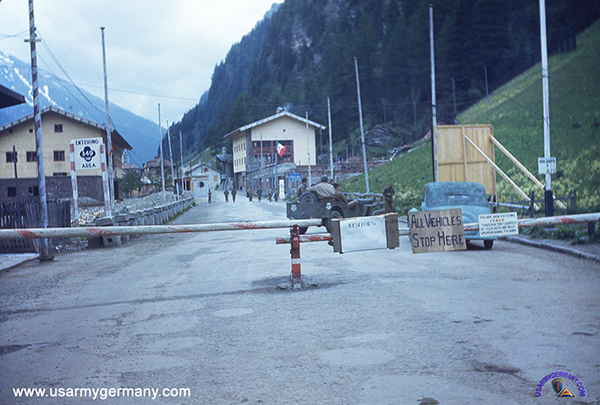
The Brenner Pass - border between Italy (South Tyrol) and Austria (North Tyrol),
Summer 1945 (Webmaster's collection) |
|
| (Source: Source: Seventh Army/Western Military District Report of Operations, 8 May - 30 September 1945) |
Seventh Army's Role in the Occupation of Austria
On 10 May 1945, Seventh Army issued instructions (Operation Instructions No. 153) that defined the Army's sector and ordered the regrouping of units for occupation. The boundaries were described as the Rezia Pass, Brenner Pass, and the Salzach and Enns Rivers. VI Corps, with its CP established at Innsbruck (Tyrol), was ordered to assume command of its sector and establish Prohibited Frontier Zones along the Austrian-German Frontier, Austrian-Swiss Frontier and Austrian-Italian Frontier in its sector. XV Corps, with headquarters in Salzburg, was instructed to occupy its assigned sector as far south as the Salzach-Enns River line and assume control of its sector. The Corps was alos ordered to establish a Prohibited Frontier Zone along the German-Austrian Frontier within its sector. XXI Corps, with its CP located south of Rosenheim, was to be relieved by Third Army's III Corps and then relocate to Schwäbisch Gmünd where it would assume its occupational mission of security and military government of Württemberg.
The boundary between the Seventh and Third Armies was changed twice, once on 13 May and again on 16 May. On 21 May, the boundary between the two armies was changed once more when XV Corps at Salzburg together with all of its assigned and attached units was transferred to Third Army control. This left Seventh Army with only VI Corps in Austria. On 6 June, Seventh Army's involvement in the occupation of Austria came to an end when VI Corps was also placed under Third Army control. This relief was necessary to allow Seventh Army to eventually move to Heidelberg and assume its primary role as one of the two designated Armies of Occupation with the mission of controlling the Western Military District, one of the two principal occupation areas in Germany. |
|
|
|
| (Source: The Evolution of the Occupation Forces in Europe - Occupation Forces in Europe Series. Published by the European Command, 1948.) |
| The Occupational Troop Basis for Austria |
|
Early in 1945, the Joint Chiefs of Staff approved an occupational plan (JCS 942/5, 4 Jan 45) that contained the first authoritative troop basis for the occupation of Germany. This paper did not include an occupational troop basis (OTB) for Austria as no decision had yet been reached on the governmental level on the question of American participation in the occupation of Austria. However, the paper in question did contain certain estimates concerning the forces to be needed, if the United States became an occupying power in Austria.
It was estimated that the number of troops needed would be 73,000 during the period from 4 to 12 months after victory was gained in Europe, and 28,000 after one year. The initial ocupation force for Austria was envisioned as consisting of two infantry and one armored divisions with supporting service troops. It was thought that this force could be reduced to one division and a regimental combat team after about one year. (It should be noted that the plan presumed that the ground and service forces for the occupation of Austria would be furnished by the Mediterranean Theater of Operations.)
Early in the summer of 1945 the US Government decided to accept a zone of occupation and participate fully in the occupation of Austria. After the decision had been made, the European Theater Commander was directed to provide a "balanced force of approximately two divisions" for the occupation of Austria. In July the Allies set the borders dividing the country into four occupation zones with the US assuming control of a zone that included the provinzes (Land) of Salzburg and most of Upper Austria (former Upper Donau). Theater Headquarters accordingly set the OTB for Austria at 28,038 but made no final decision on the composition of the forces. At this time, consideration was being given of using one corps headquarters with one or two infantry divisions.
By mid-August 1945, however, the trend of thought at Theater Headquarters was in favor of employing only one division in Austria, together with lesser combat elements within the troop ceiling of 28,000. General Mark Clark, CG and US Commissioner for Austria, expressed the opionion that, until about 1 April 1946, the forces in Austria should include two infantry divisions, two cavalry reconnaissance squadrons, and two tank destroyer battalions. He believed that, after the date mentioned, an OTB of one reinforced division would suffice.
1946 - During the first six months of 1946, the authorized strength of US Forces, Austria, was 29,000. The only large combat unit included in its troop list was the 42nd Infantry Division.
To be continued |
|
|
|
|
STARS & STRIPES article that appeared in the June 21, 1945, issue announcing the designation of the 42nd Infantry Division and 65th Infantry Division as occupation units in Austria.
Click on image to view article
|
|
|
|
| (Source: Email from Jim Zuidema, 65th Inf Div Assn.) |
(Jim was a member of the 65th Infantry Division during WWII.) The 65th had just liberated Linz when the war ended. We stayed put until we were deactivated in Aug, I think.
Div Hq was in Linz and my unit, Hq Divarty, was in St. Florian when the war ended. Later Divarty moved to Bad Schallerbach were we had a POW camp. There were several in our territory. We sent them home as fast as possible if they were not SS. If you have read or saw "Schindler"s List" you might be interested to know that he turned himself over to us. However the location of his letter signed by all his Jewish workers is a mystery to us, we think it was lost in the St. Louis fire.
When the 65th was deactivated, I was sent to the 26th Inf Div near Braunau. (Hitlers birth place) We had relieved the 26th on the line when we went into combat at Saarlautern. When the 26th went home I stayed put in the same town and house for a week and the 83rd Inf Div moved in.
When they went home, I was sent to Vienna were I became the chief clerk in Gen. Clarks office. My desk was just outside his private office. When anyone of fame came to see the Gen, he always introduced us all to them. Herbert Hoover was the main one, we also met many of royalty who were trying to get their estates, etc back. also Chancellor Figal and many other high officials. I truely believe that Clark was a fine man and got a bum rap down in Italy. He didn't like to wear ties and wore scarfs instead, so all his men did too.
While in Vienna our Sunday afternoon outing was in Hitler's car. This was the one from Bertchesgarten.
In 1987 I returned to Vienna on a singing tour. I went back to all the places I had been in '46. Our office was in the Bank of Austria building, this is something like our Treasury building. The office is now the office of the President of the bank. Security is very high so I could not get up to it. However, they sent a sec down to talk to me. I told him just where my desk sat and they took a Poloroid of it. They said it might look different since they had had a fire there several years before. I in turn gave them pictures of the Imperial Crown Jewels which we had in their valt when they were returned to Vienna from Nurenburg. They had no idea that they had been there. So I had filled them in on a little history. I saw all the jewels at the Palace where they had just been put back on display after many years. I talked to one of the officials and showed him the pictures and they were also happy to learn of that part of its history too. I was one of the youngest to see action in WWII. I am now just 78.
All in all, I was in Austria about 13 months, very good months at that. If I can answer any other questions, please ask. Thanks. God bless.
Jim Zuidema |
|
|
|
| (Source: OCCUPATION SERIES, 2nd Year, Vol. VII) |
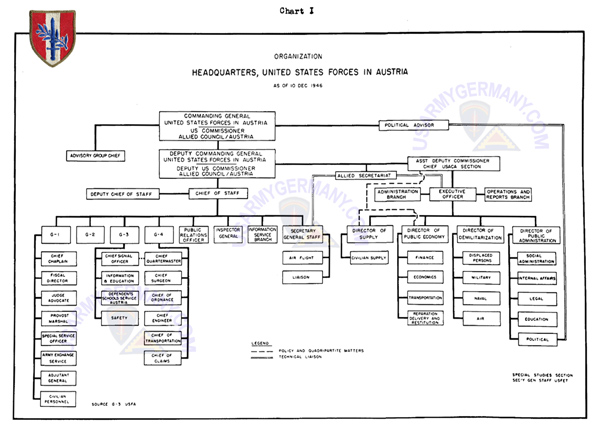
Headquarters USFA Organization in December 1946 |
|
|
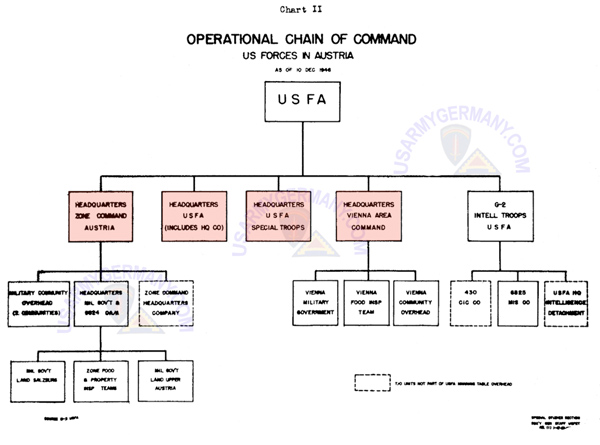
USFA Operational Chain of Command, December 1946 |
|
|
The American occupation forces in Austria, designated as U.S. Forces, Austria (USFA), operated as a semi-independent command under Headquarters, USFET, until 15 March 1947. After that date, USFA came under Headquarters, European Command.
The European Command in Frankfurt provided tactical, administrative, and logistical support to USFA, but, as respects Civil Affairs, USFA operated independently of EUCOM.
In the purely military aspects of the occupation of Austria, the Commanding General, USFA, was responsible to the Commanding General, USFET, and his successor, the Commander in Chief, EUCOM. In the political and military government aspects -- Civil Affairs -- of the occupation of Austria, the Commanding General, USFA, in his capacity as US Commissioner for Austria, was responsible directly to the Joint Chiefs of Staff in Washington, DC.
The organization of the American occupation forces in Austria resembled that of the occupation forces in Germany -- it was directed by a military staff with jurisdiction over tactical, security and service troops and a military government staff having jurisdiction over the civil government. Both staffs reported to the commanding general (of USFA) who was at the same time the military commander and the military governor in the US occupied portion of Austria. (In his capacity as military governor, the commanding general also served as the US member of the four-power council which was the supreme authority in Austria.)
Unlike Germany, however, there was a closer integration of military and military government staffs in Austria, with both of them (in the early years) located in Vienna. The military government staff, known as US Element, Allied Commission, Austria (USACA), Section, was structurally one of the general staff divisions of Headquarters, USFA. The USACA Section performed the normal functions of a G-5 division in a amajor headquarters.
ORGANIZATION IN JULY 1946
The principal elements of USFA in July 1946 were
  Headquarters, USFA, located in Vienna Headquarters, USFA, located in Vienna
  Vienna Area Command, also in Vienna Vienna Area Command, also in Vienna
  Headquarters, Zone Command, located in Salzburg Headquarters, Zone Command, located in Salzburg
Gen Mark W. Clark was Commanding General, USFA, from its inception until 17 May 1947, when he was succeeded by Lt Gen Geoffrey Keyes. Headquarters, USFA had a normal general and special staff, except that the Civil Affairs element was greatly expanded.
The Vienna Area Command (VAC) corresponded to Berlin District when that command was separate from OMGUS. Headquarters, VAC had staff sections distinct from those of Headquarters, USFA. Vienna Area Command combined ordinary military functions of security, discipline, and supply with Civil Affairs functions in the US Sector of Vienna. It maintained the Vienna Military Community, later known as Vienna Military Post. Its commanding officer was responsible for the military government of the US sector of Vienna and served as the United States member of the Vienna Inter-Allied Command, which corresponded to the Berlin Kommandatura.
The Zone Command (ZCA) had tactical control over the entire US Zone of Austria, and thus corresponded in many ways to the Third US Army in the occupation of Germany. ZCA also combined ordinary military functions with Civil Affairs functions. The Commanding General, Zone Command, Austria, was at the same time the senior military commander and responsible for military government in the US Zone, Austria. He discharged the latter responsibility through the Chief Military Government Officer, US Zone, who held a position analogous
to an Assistant Chief of Staff, G-5, in a major command. |
|
|
| |
| (Source: 42nd Infantry Division Veterans Association ) |
| A Year of Progress - The Commanding General Reviews 42d's Occupation |
| Click here to read a summary of the 42nd Infantry Division's first year of activities and accomplishments as the occupation force in USFA. |
|
| |
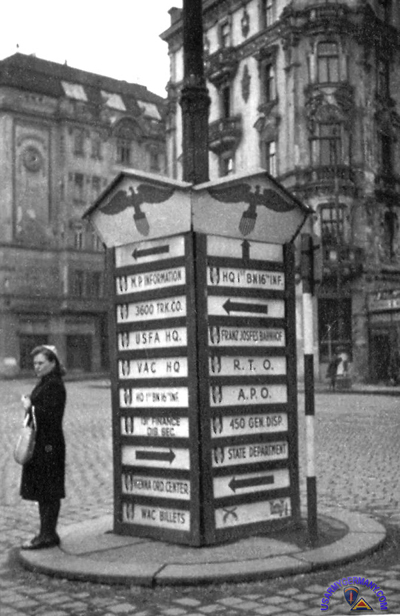
Signs point to various USFA units and activities in Vienna |
|
| |
| 1948 |
| (Source: STARS & STRIPES, February 11, 1948) |
USFA Headquarters has announced that Vienna Area Command and USFA Special Troops will be consolidated into a new command, to be designated as Headquarters Command, USFA.
Commanding general of the new command will be Brig Gen Alexander O. Gorder, currently serving as CG of Vienna Area Comd. All troop units in Vienna will be placed under the administrative control of Hq Comd, USFA. |
|
 |
|
| |
| 1949-55 |
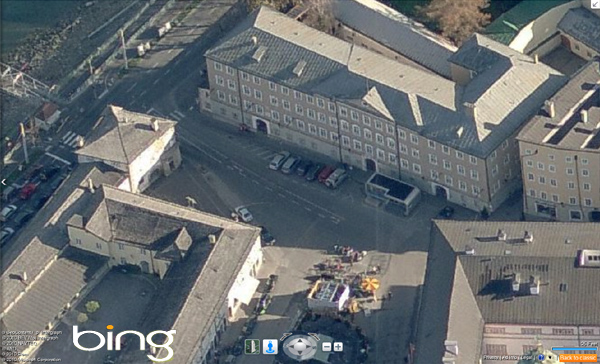
Former Command Post on Mozartplatz, Salzburg (Bing Maps) |
| |
| Check out the Bing Maps site to view (aerial or bird's eye view) downtown Salzburg and the former Command Post building from various angles. Very nice! |
| |
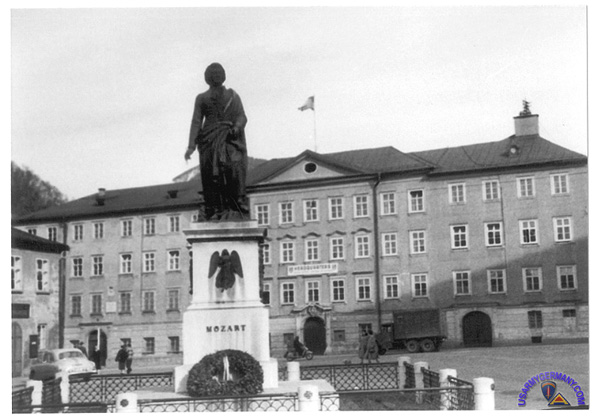
Headquarters USFA on Mozartplatz, Salzburg (Donald Maloney) |
|
|
| |
| (Source: ARMY NAVY & AIR FORCE JOURNAL,
19 March, 1949) |
United States Forces, Austria
By Lt. Gen. Geoffrey Keyes
Commanding General, U.S. Forces in Austria
May, 1949, will mark the fourth anniversary of the activation of Headquarters, United States Forces in Austria (USFA), which is charged with the mission of reestablishing a free, independent and democratic Austria, possessing a sound economy capable of insuring an adequate standard of living.
Progress toward fulfillment of this mission has resulted in numerous changes in the detailed organization and functions of USFA, a natural result of our gradual readjustment from an initial policy of strict military control over the impoverished and disorganized country at the end of the war, to a policy of observation, advice and assistance to a freely-elected and capable Austrian Government, to which the great majority of controls and responsibilities has been returned. Coincident with the release by USFA of these functions and responsibilities, a gradual but large reduction of headquarters personnel and troop strength has logically taken place.
USFA today consists of USFA Headquarters in Vienna, Headquarters Command which administers the US Sector of Vienna, and Headquarters Zone Command in Salzburg which administers the US Zone of Austria, the nearest area of which is separated from Vienna by some one hundred miles of Soviet Zone. Headquarters Zone Command has two major subordinate area commands with areas of responsibility fixed according to Austrian political boundaries; Land Upper Austria Area Command with headquarters at Linz and Land Salzburg Area Command with headquarters at Salzburg.
USFA Headquarters is an integrated headquarters which discharges both Civil Affairs and Military functions. The Commanding General, USFA, is also the U.S. High Commissioner in Austria. In his capacity as High Commissioner, he is responsible directly to the Joint Chiefs of Staff in Washington for all Civil Affairs matters. As the Commanding General, USFA, he is responsible for military matters to the Commander-in-Chief, European Command in Germany. The Civil Affairs functions of the headquarters are very closely coordinated with the United States Legation in Vienna. To ensure this coordination, the US Minister to Austria, the Honorable John G. Erhardt, is also Political Advisor to the High Commissioner. Similarly extremely close coordination has been achieved with the Economic Cooperation Administration (ECA) in Austria where the Chief of the ECA Mission, the Honorable Clyde N. King, is also Economic Advisor to the High Commissioner.
USFA troop units are stationed in the US Zone of Austria and the US Sector of Vienna. These units are practically all committed on stationary occupation duties in support of Civil Affairs activities and presently include the 350th Infantry and 4th Constabulary Regiments with supporting troops.
Contrary to the opinion of many people, there are several major differences between the Occupation of Austria and that of Germany. Austria has in existence a Federal Government elected by popular vote, with active executive, legislative, and judicial bodies. Germany has no central government. Unlike Germany, Austria is a liberated, not a conquered country. In Germany, there is complete control administered by a strictly Military Government Organization (OMGUS), with its separate Chain of Command. In Austria, the days of strict control passed in June 1946, with the signing of the New Control Agreement by the four occupation powers, to a completely Civil Affairs status insofar as the US Occupation Forces are concerned. The resulting Civil Affairs functions are administered by a comparatively small staff of experts who are an integral part of USFA, a staff section (USACA) with no separate organization or Chain of Command. In addition, there is still in existence in Austria an Allied Commission composed of representatives of the four occupying powers at the Allied Council, the Executive Committee, and Directorate levels, which continues to meet regularly.
It is the United States policy in Austria to turn over responsibility to the Austrian Government as rapidly as the Government is capable of accepting it and this policy is invariably followed by the US Element in the Allied Commission. Where agreement cannot be reached because of Soviet reluctance to relinquish control, our policy is to turn over the responsibility to the Austrian Government in the United States Zone except where such action might place the Government at a disadvantage with one of the occupying powers.
Although Austria's progress to date is very encouraging, she is far from self-sustaining. Much of her industrial and transportation equipment is badly in need of repairs, spare parts, and replacements. Industry, having been geared to the German economy and war effort, must be rebalanced. Over-expansion in certain heavy industries must be replaced by the development of appropriate production of finished and semi-finished goods which can furnish the necessary foreign credits for the import of food, raw materials, and capital equipment. Soviet removals of industrial equipment, oil, and machine tools claimed as German assets and war booty have increased the economic problem. In addition, there is the heavy burden of four-power occupation.
Despite the serious obstacles of the past and the different problems still to be overcome. Austria has established a firm foundation for rehabilitation and her people and Government have demonstrated the strength of character and industry necessary to rebuild a sound economy. The relief supplies and assistance given to Austria have been judiciously distributed and profitably utilized. Industry, almost at a complete standstill at the end of the war, has steadily increased production, particularly the basic chemical, wood, textile, paper, metallurgical, and machinery and equipment industries. In October 1948 production of pig iron, magnesite, crude steel, rolled steel, aluminum, ball-bearings, incandescent lamps, and soda ash exceeded average monthly production in 1937, her last pre-war year as an independent nation. Although still 700 calories below that of normal years, the food ration for the normal consumer was raised twice during 1948 and the Austrian people are presently better fed, housed, and clothed than at any time since 1945. Employment at the end of September 1948 was the highest in Austrian history. With further assistance by the shipments of capital goods and essential ra materials through the European Recovery program, Austria can again become self-sustaining and an asset to the world of nations. She has earned this chance. |
|
|
| |
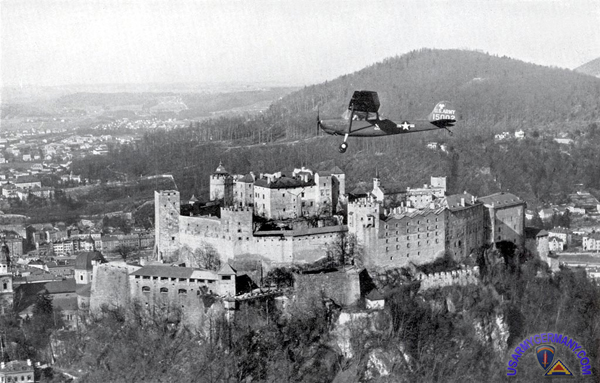
US Army liaison plane flies past the Hohensalzburg Festung, 1950s |
|
| |
| 1951 |
(Source: "Orientation Pamphlet", not dated but probably published in 1951) |
Destination USFA
General Information for Personnel Alerted for Shipment to United States Forces in Austria
|
|
This booklet was issued to personnel who have recently received orders to ship out to USFA in the early 1950s. We have selected excerpts from the booklet that we hope will be of general interest and can serve as a general overview of the USFA organization and mission at that time.
1. Introduction
The purpose of this booklet is to furnish interesting and useful information to persons newly assigned to United States Forces in Austria and to their dependents, and to bid them welcome to this important and interesting command. The present members of "the USFA team" hope you will join them with pride and pleasure.
2. Your Assignment
Each area of assignment at home and abroad has advantages and disadvantages when compared with other areas. This is true of USFA and the various commands within USFA, but the advantages so far outweigh the disadvantages as to make this one of the choice areas for oversea assignment.
USFA units are located throughout the US Zone of Austria, in Vienna, and in northern Italy. Personnel requirements are constantly changing and both military personnel and civilian employees must be prepared for initial assignment and subsequent transfers to any of these areas.
3. Why we are here
The USFA Mission. The mission of United States Forces in Austria is to "provide a security force capable of supporting the High Commissioner for Austria in his endeavor to re-establish a free, independent, and democratic Austria, with a sound economy capable of insuring an adequate standard of living."
4. Organization of USFA
USFA was established on 5 July 1945. Its insignia is the shield with sword and olive branch (shown at the top of this page). The colors combine the red, white and blue of the United States and the red, white and red of Austria. The sword represents protection and security for Austria in its struggle for complete sovereignty. The olive branch indicates that the most important mission of USFA is the preservation of peace.
There have been numerous changes in the organization and location of United States Forces in Austria since the command was first established. At present the headquarters is located in Salzburg, Austria, with four major subordinate elements organized and disposed as follows:
TACTICAL COMMAND, organized along the lines of an infantry division, is a highly mobile striking force. It is responsible for the training and tactical employment of USFA combat elements. Headquarters, Tactical Command, is located at Camp Roeder, on the outskirts of the City of Salzburg, while units of the command are disposed over a wide area.
AREA COMMAND, with headquarters at Camp Riedenburg in Salzburg, is responsible for the operation of all installations in the US Zone of Austria, except Vienna. Included, in addition to Camp Riedenburg, are Camps Roeder and Truscott in Salzburg, Camp McCauley at Wels, sub-posts at St. Johann, Saalfelden and Lofer. In addition, Area Command is also responsible for the operation of the storage depot in the American portion of Camp Rum, near Innsbruck, which is in the French Zone of Austria.
VIENNA COMMAND is responsible for the administration and operation of United States units in Vienna. In addition, the Commanding General, Vienna Command, is the American representative on the Vienna Inter-Allied Command, which administers the International Sector of Vienna. Military Policemen of the Vienna Command perform normal MP duties in the American sector of the city, but are better known for their participation in the International Patrols ("four men in a jeep"), which maintain law and order in the International Sector. Tulln Airbase, about 15 miles from Vienna in the Russian Zone, is operated by the 12th United States Air Force but receives its logistical support through the Vienna Command.
SUPPORT COMMAND operates the USFA port at Leghorn, Italy, and the general depot at Camp Darby. Nearly all personnel and supplies that come to USFA by surface transportation enter through the port of Leghorn. This ancient maritime city is located on the Mediterranean coast of Northern Italy and appears on most maps as Livorno. In addition to the facilities in the Leghorn area, Support Command is also responsible for the Storage Point at Verona, Italy.
37. Arrival in Europe
Most passengers travel by surface ship from New York to Leghorn, Italy, but some arrive at Genoa, Italy, and at Bremerhaven, Germany. The remainder of the trip is by train. Most air travelers fly to Rhein Main Airport at Frankfurt, Germany, and continue by train to USFA. Some chartered planes land USFA passengers at Munich, Germany, where they are met by USFA busses. The following table shows distances and rail time to Salzburg, Austria, from these various ports of debarkation. |
|
| |
| To Salzburg from: |
Rail time: |
Distance: |
| Leghorn, Italy |
21 hrs 15 min |
523 miles |
| Genoa, Italy |
21 hrs 40 min |
521 miles |
| Bremerhaven, Germany |
21 hrs 30 min |
666 miles |
| Frankfurt, Germany |
10 hrs 26 min |
341 miles |
| Munich, Germany |
2 hrs 32 min |
92 miles |
| (Salzburg to Vienna) |
4 hrs 20 min |
212 miles |
|
|
| |
Special trains or accommodations on regular trains are provided for the onward journey from the debarkation ports. Military personnel and facilities are available to assist travelers at Leghorn, Genoa or Bremerhaven, and at the Air Returnee Center at Frankfurt. Dependents need not fear that they will be left "on their own" or unassisted during the final leg of their journey. There are US Army Rail Transportation Officers (RTO's) in the rail stations in all of the larger cities where information or help is available in emergencies. Sponsors may meet their dependents arriving at Leghorn, duty permitting. Sponsors are not permitted to greet dependents arriving at Leghorn personally until after customs clearance has been obtained and are strictly prohibited from going aboard ship.
All incoming personnel should have five copies when they disembark, and if they go to Vienna they need two more when they reach Salzburg. |
|
|
| |
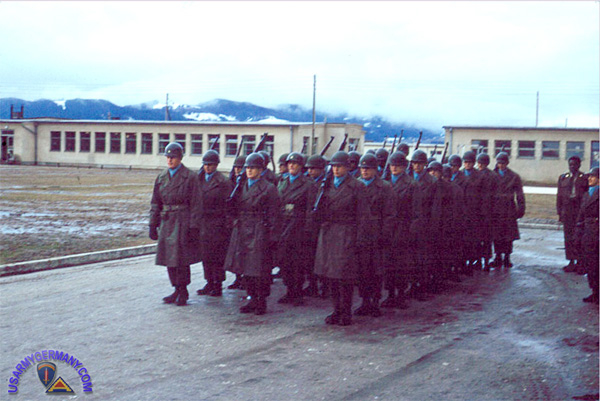
350th Infantry at Camp Roeder, Salzburg |
|
| |
| 1952 |
| (Source: ARMY NAVY & AIR FORCE JOURNAL, 20 September, 1952) |
U.S. Forces in Austria
By Lt. Gen. George P. Hays, USA
U.S. Forces in Austria, a separate command, are charged with the mission of supporting the U.S. High Commissioner of Austria in his effort to reestablish a democratic Austria with a sound economy capable of insuring an adequate standard of living.
The importance of this small but strategically located country is noted when studying a map of Europe. From the standpoint of Western Europe security, Austria constitutes the Eastern-most salient of the free-nations of West Europe. This mountainous country has common borders with two of the Soviet satellites - Czechoslovakia and Hungary - forms the southern flank of Germany, and extends to the northern boundaries of Italy and Yugoslavia.
Important for its water and trade routes, Austria boasts the Rhine-Danube, main waterway of Europe, which borders the U.S. Zone on the north and flows on through Vienna. The north-south route through the Brenner Pass to Italy is the most important rail and highway route through the Alps. The southwest routes from Russia and Poland intersect with the others to make this a "cross-roads" country.
U.S. Forces in Austria (USFA) are composed of four military posts at Salzburg, Vienna, Linz, and Leghorn, Italy. The latter is USFA's Port of Embarkation from which the logistical support emanates.
The Festival City of Salzburg is the site of the largest concentration of U.S. troops, quartered in various camps around the city. Here USFA headquarters are located.
Traveling eastward, famous landmark in the Linz Military Post area, is the Soviet checkpoint at Enns, last outpost before starting the 110-mile trip through the Soviet Zone top Vienna.
Vienna is divided into four sectors, plus the International zone, which are administered directly by the Vienna Inter-Allied command. This command consists of one city commander and deputy from each of the four Powers, and each has a representative for administering the International bezirk (district).
Each month, a different Power assumes control of the International bezirk. During July, the French administered, with the USSR, US, and British following in that order. In addition to the Austrian police, five colorful International patrols, each consisting of one military policeman from each of the four Powers, police the city. Inspections of the patrols rotate daily among officers of the four Powers.
Tactical Command
Tactical troops of U.S. Forces in Austria are commanded by a Headquarters appropriately named "Tactical Command." Tactical training in USFA begins on the squad and platoon level, working up to combined American and British or French maneuvers. Austria's topography is sufficiently varied to permit training of troops in all types of terrain.
Exercise REBOUND in the summer of 1951 taught infantrymen of USFA how to operate in hot weather on terrain that is fairly level with some rolling hills. During Exercise MULE TRAIN in the French Zone of Austria last fall, USFA infantrymen doubled as mountain troops. Exercise AVALANCHE held this spring in the mountainous Arlberg area of Austria, gave USFA's ski troops a taste of rugged winter warfare in mountains as high as two miles with 20 feet of snow. USFA's artillerymen learned to get their big guns over almost impassable roads and dug-in, surrounded by walls of snow. Other combined French-American and British-American maneuvers instruct USFA's troops in the geographical details of Austria and Southern Germany. These joint maneuvers also give American men and officers practical experience in coordinating their actions with other Allied powers in Austria.
River Crossing Exercises
Other tactical training consists of problems and exercises similar to those taught the soldier in the United States. Because of the many mountain streams and rivers in Austria, river crossing exercises are an integral part of the USFA soldier's training. For unit firing exercises up to company-level, USFA tactical troops practice fire and movement on the maneuvering area at Grafenwoehr, Germany.
Just as in the United States, training is a continuous process in Austria. Training on an individual basis is done by requiring a certain percentage of the command to attend schools, operated by USFA. The Tactical Command NCO Academy graduates a class of intensively-trained soldiers every eight weeks. USFA personnel also may take advantage of the high standard of teaching offered in various Army schools throughout the European Command. The USFA Troops Information and Education program presently is engaged in educating the soldier with courses designed to improve his skill in military occupation.
|
|
|
| |
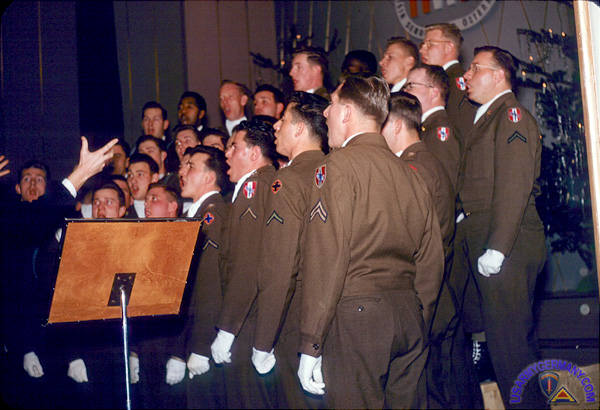
USFA Soldiers Chorus performs for US troops and Austrian civilans |
|
| |
| 1953 |
| (Source: Orientation Talks, HQ SFA, July 1953) |
Click here to view a transcript of the booklet issued by the TI&E branch of the G-3 section, HQ USFA. It contains a lot of valuable information on the history, organization and mission of US Forces, Austria, status 1953.
(Portions of the photocopy of this booklet that I possess are very difficult to read, so I decided to transcribe the booklet instead of scan it.) |
|
|
|
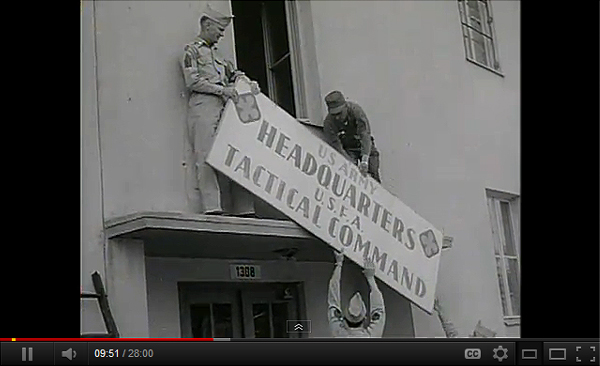
Big Picture Report #18: US Army withdraws from Austria, 1955 (starts at 0:53 - YouTube) |
|
| |
| 1955 |
| (Source: STARS & STRIPES, July 27, 1955) |
| The Big Four Powers will lower their flags on Vienna's Allied Council Building tomorrow as a sign that the four-power rule of Austria has come to an end.
Before the ceremony takes place, the council - which governed this Alpine country for 10 years - will meet for the last time to agree on the last point of its agenda - its own dissolution. The measure follows the deposition of the French ratification instrument of Austria's state treaty in Moscow, expected to be announced tomorrow morning.
The ratification instrument of the Austrian, British, Soviet and US governments already have been deposited at the Kremlin.
After the end of the brief council meeting, troops will march to Stalin Square in front of the council building to act as honor guards during the flag-lowering ceremony.
The first standard to go down will be the French tricolor, followed by the Soviet red flag, the Stars and Stripes and finally the British Union Jack as bands of the four armed forces play their country's national anthems.
At the same time, the flags of the four nations will be lowered on the imperial castle and other four-power buildings in the Austrian capital. |
|
|
|
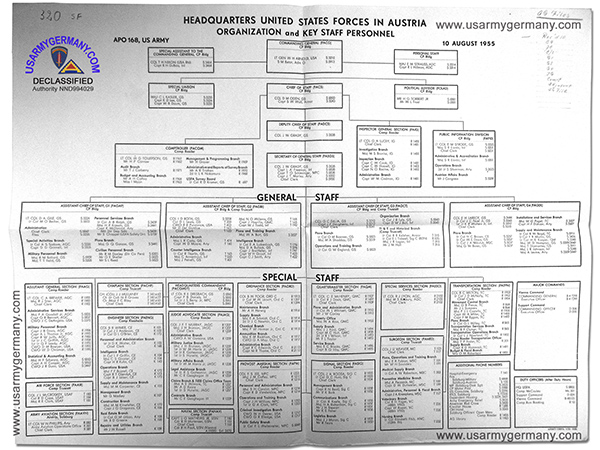
Wire diagram for HQ USFA, Salzburg, August 1955 (Webmaster's collection) |
| |
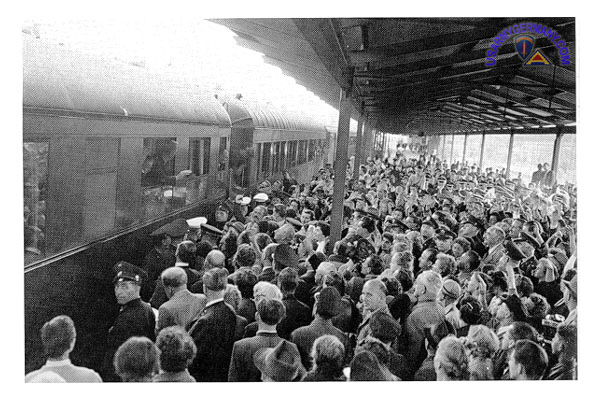
General William H. Arnold, USFA CG, waves goodbye to Austrian officials and
wellwishers at the Salzburg Bahnhof as he departs Austria on September 30, 1955 |
|
| |
| (Source: STARS & STRIPES, July 28, 1955) |
| After 17 years of occupation Austria becomes a free and independent nation today.
With the delivery of France's ratification of Austria's state treaty to the Kremlin today, the treaty - signed by the Big Four on May 15 - becomes effective.
Thousands of Viennese gathered this morning in front of the Allied High Commission Building to observe the lowering of the colors of the four occupation powers. Vienna itself was bedecked with Austria's red-white-red flags.
Prior to this ceremony marking the end of Allied rule, the High Commissioners of the US, Britain, France and the Soviet Union convened in a final formal session of the Allied Council to agree on the last point of its agenda - its own dissolution.
First to arrive at Stalin Square, site of the council building, was British High Commissioner Sir Geoffrey Wallinger, followed by the Acting US High Commissioner James K. Pennfield, French High Commissioner Francis Seydoux de Clousonne and Soviet High Commissioner I. I. Ilyichev.
With the numbers of onlookers increasing, reinforcements of Austrian police appeared to maintain order.
After learning of the deposition of the French ratification document in Moscow, Federal President Theodor Koerner told the nation in a radio address:
"The final remains of the walls which separate Austria from its freedom have now fallen.
"With a unanimity which gives just cause for new hopes of the establishment of peace in the world, the great powers of the world have leveled the road for the just solution of a much-disputed problem.
"Five times solemnly affirmed, the Austrian state treaty now rests in the archives of world history.
"The promise once given to raped Austria has been kept. We Austrians also will keep our promise never to take part in a fight other than the battle for peace and justice." |
|
|
|
| (Source: STARS & STRIPES, Sept. 27, 1955) |
| On September 26, the U.S. transferred to Austria title to all buildings, roads, utilities and related installations constructed by U.S. Forces in Austria with dollar funds appropriated by Congress.
An agreement for the transfer was signed in the Austrian chancellery by Lt Gen William H. Arnold, USFA commander, and by Austrian Vice Chancellor Adolf Shaerf.
The buildings and installations included a large amount of installed equipment, heating plants, communication facilities, machine tools and similar equipment. The
cost to the U.S. of all items transferred was approximately $22,000,000.
In return for the American property, the Austrian government agreed to absorb USFA's cost for rail transportation and communications within Austria and USFA's
terminal rental costs since last Aug. 31, as well as real estate, restoration and damage claims against USFA which remained unsettled as of last Jury 27, the date the Austrian state treaty took effect. It was estimated that these costs to be absorbed by the Austrian government wfll not exceed $1,500,000. The installations transferred were constructed between 1951 and 1955. The greatest concentration of property, which cost almost $17,000,000, was at Camp Roeder, outside Salzburg.
Installations at the camp include barracks and mess halls which can accommodate 10,000 soldiers, two gymnasiums, one chapel, 16 administrative buildings, one theater, one high school for 700 students plus a dormitory for teachers and transient students, athletic fields and parking areas. In addition, there are motor shop facilities, numerous warehouses, engineer shops, gasoline stations and a large laundry and dry cleaning plant.
There are also 444 apartments constructed at the west end of Camp Roeder. Actually the last building was completed Aug. 31, after the state treaty went into
effect, and 114 of the apartments were never occupied by Americans.
The agreement did not involve the large amount of U.S. military equipment which has been made available to Austria from the reserve stocks that USFA had in Austria
and which is expected to be of invaluable assistance in equipping the Austrian Army. |
 |
|
| |
| Director of Logisitcs, HQ USFA |
| |
| 1949 |
| (Source: USFA Logistical Status and Forecast Report, HQ USFA, August 1949) |

Organization of the Directorate of Logistics, HQ USFA, July 1949 (Webmaster's collection) |
| |
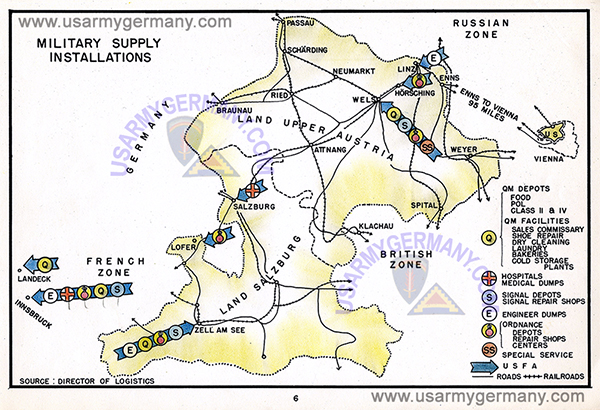
Units & installations under the control of the Dir., Logistics, 1949 (Webmaster's collection) |
|
|
| |
| Allied Forces in Vienna (1945-1955) Book Project |
| |
Mr. Hubert Prigl, an Austrian Historian working for the City of Vienna, is collecting information and photos of buildings and installations that were occupied and used by the Allied Forces in Vienna during the 1945 - 1955 time frame. This includes the kasernes, headquarters, administrative and support buildings, supply points, billets, transient hotels, snack bars, American Red Cross and special sevice clubs, Rail Transport Offices and the many family quarters used by military and civilian personnel of the US Army and Air Force and their families stationed in the Greater Vienna area.
Much of the information and many of the photos will be used in a book that he is working on: Volume 6 of the series "Wien. 2000 Garnisonstadt" (The 2000 year history of Vienna as a garrison city.) The book will be published by the Weishaupt Verlag (publishing house) in Austria.
You can contact the webmaster or Dr. Prigl directly via email. |
|
|
| |
| Telephone Directory - HQ USFA (February 1946) |
| |
| (Source: Author's personal collection) |
|
 |
|
| |
| Telephone Directory - Salzburg Area (early 1949) |
| |
(Source: Author's personal collection)  |
|
|
 |
|
| |
| Additional Telephone Directories - Vienna Area |
| |
| (Source: Author's personal collection) |
|
|
Headuarters USFA
VIENNA TELEPHONE DIRECTORY
October 1949
Click on image to view article
|
|
|
|
| (Source: Author's personal collection) |
|
|
Office of the US High Commissioner for Austria
VIENNA TELEPHONE DIRECTORY
November 1953
Click on image to view article (not yet) |
|
|
|
| (Source: Author's personal collection) |
|
|
US Military & USCOA
VIENNA TELEPHONE DIRECTORY
October 1954
Click on image to view article
| SECTION |
|
STARTS AT |
|
| Abbreviations Used |
|
Page 4 |
|
| Headquarters Vienna Command |
|
Page 9 |
|
| US High Commissioner for Austria |
|
Page 21 |
|
| Tulln Air Base |
|
Page 33 |
|
|
|
 |
|
| |
Related Links:
 |
|
202nd Military Police Company - Jeff Mack hosts a website for former members of the 202nd MP Company. This link goes directly to the Austria Section of the website which has - at last count - eight pages of great photos submitted by MPs who served in USFA in the 1940s and early 1950s. |
|
 |
|
Blue Danube Network - A nostalgic Austrian website that keeps alive the memories of the US Forces radio service that served US troops in the USFA area of operations. Similar to the experience of AFN in Germany, BDN was widely listened to by civilian audiences. |
|
 |
|
Die Geschichte des Fliegerhorst VOGLER  - An Austrian website (only in German) that covers the history of the Fliegerhorst (formerly Camp McCauley) from its beginnings as part of a major military construction program in Austria after the annex of that country by the German Reich in 1938 through the Occupation by US Forces after WWII to its final use as a major Austrian Air Force installation after the 1955 State Treaty. - An Austrian website (only in German) that covers the history of the Fliegerhorst (formerly Camp McCauley) from its beginnings as part of a major military construction program in Austria after the annex of that country by the German Reich in 1938 through the Occupation by US Forces after WWII to its final use as a major Austrian Air Force installation after the 1955 State Treaty. |
|
|
| |
| |
|
